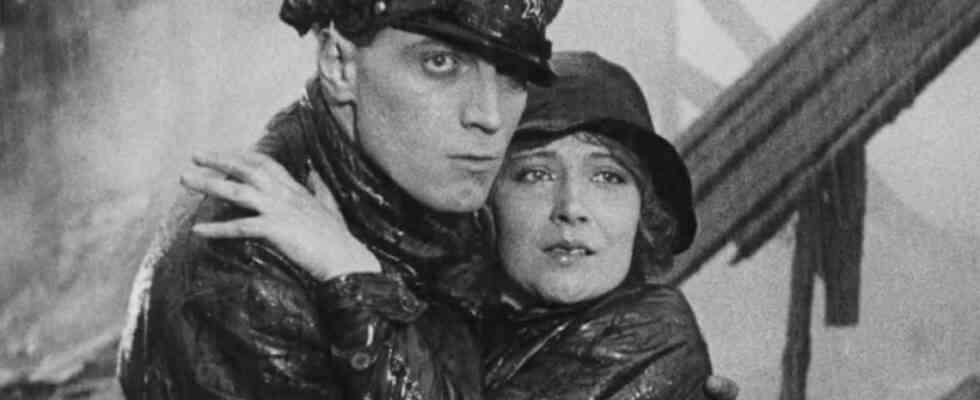The film begins grimly – civil war in the Crimea, after the Russian revolution: “Fanatical fighters on both sides. Hunger and misery in the country. Easy earnings for unscrupulous existence.” The film, “The Love of Jeanne Ney”, 1926, by GW Pabst, is packed with such existences, with the nasty game they pull off, with plenty of male toxic stupidity. A man frantically thumbs through a few bundles of banknotes – a silly thing, because he won’t get the money until tomorrow as a reward for a precious stone he has found again. Add to that theft, fraudulent marriage – on a blind young woman – clumsy come-ons.
“Jeanne Ney” is one of the surprises among the 26 films in the small series “Seeing Weimar”. Streaming service La Cinetek is currently on the program, about German cinema between 1918, the end of the First World War, and 1933, when the Nazis took power. Of course, the series brings together all the classic film protagonists who define our image of the epoch, Caligari and Mabuse and Nosferatu – monstrous manipulators who decompose the bourgeoisie of the post-war period. Siegfried Kracauer called them tyrant figures in his book “From Caligari to Hitler”, in anticipation of the great tyrant Hitler. Professor Rath is also one of them, embodied by Emil Jannings, who in “Der Blaue Engel” is the showgirl Lola Lola – Marlene Dietrich! – expires and henceforth earns his bread with Kikeriki.
La Cinetek was established in Paris, inspired by the world-famous Cinémathèque française, where the cinema of the Weimar period, the “Demonic Screen” (Lotte Eisner), was early appreciated and collected. The streaming service, which has also been available in Germany since 2019, turns modern filmmakers into curators, they compile lists of the most important films in cinema history.
La Cinetek tries to get as many of them as possible into its program – again and again in special series, like now on Weimar. So you can see the films chronologically, but also vertically – what traces has “Nosferatu” left with Christian Petzold, Martin Scorsese and Dario Argento, who have it on their leaderboards, “Metropolis” with Paul Schrader, Fritz Lang’s “Spione” with Olivier Assayas, “Menschen am Sonntag” by Maren Ade, Jutta Brückner and Raymond Depardon, or Lang’s “M” by Christoph Hochhäusler?
The Weimar films are drawn together, reduced to oppressive, oppressive bourgeois interiors. These then become scenes of lust and trauma, particularly rigorously in the case of GW Pabst, in “Pandora’s Box” with the unapproachable Louise Brooks, or in the film adaptation of the “Threepenny Opera”, against which Bert Brecht unsuccessfully filed a lawsuit. “The Love of Jeanne Ney”, on the other hand, is, despite all the unscrupulous existence, a casual, amorous film. After starting in Crimea, it quickly moves to Paris, the city of love, is filmed on the streets in front of the Gare du North and next to Notre-Dame, as if you were already in the Nouvelle Vague. No wonder the film is on Wim Wenders’ wish list.
An “inflation cinema” is created, it shows the decline of all values
French esprit can also be experienced in “Ariane”, staged by Paul Czinner based on the novel by Claude Anet, Ariane is played by Czinner’s wife Elisabeth Bergner – both emigrated to England shortly afterwards – a young, very self-confident, so somehow rebellious girl who Problems with its ideas of freedom when it falls in love with an older man: Rudolf Forster – who in the same year 1931 was Mackie Messer in Pabst’s “The Threepenny Opera”. A love between an older man and a girl that still seems incredibly modern today because it is changeable, without promises and without the phantasm of fulfillment. You know the end of the story – the man leaves town for a trip into the wide world and at the last second pulls the girl off the platform onto the moving train – from the version by Billy Wilder, 1957, with Audrey Hepburn and Gary Cooper.
In “Der Katzensteg”, 1927, by Gerhard Lamprecht, French always plays a role as an alternative to Prussian discipline and compulsory ideology. The film, which has just been restored by the Deutsche Kinemathek in Berlin, is set at the time of the Napoleonic Wars. It is about collaboration and betrayal, disloyalty and solidarity, about the moments when the greatest emptiness becomes noticeable in the rigid ceremonial. Men brutally grab women if they try to resist them… A young nobleman lives in the ruins of his castle as lonely and self-sufficient as Count Orlok, the “Vampyr” in “Nosferatu”.
Ernst Lubitsch opposes the desire to manipulate with the omnipotence of the playful, in his early comedies “Die Austernprinzessin” or “Die Bergkatze” – there has never been so much anarchy in German cinema, the laws of the market and action are shamelessly exploited and decomposed here. Enno Patalas called Lubitsch’s films “inflationary cinema” because “they show the decay of recognized values. The films themselves show how something is used up, worn out, consumed. And the change from one film to another obeyed the same principle of productive consumption”.

